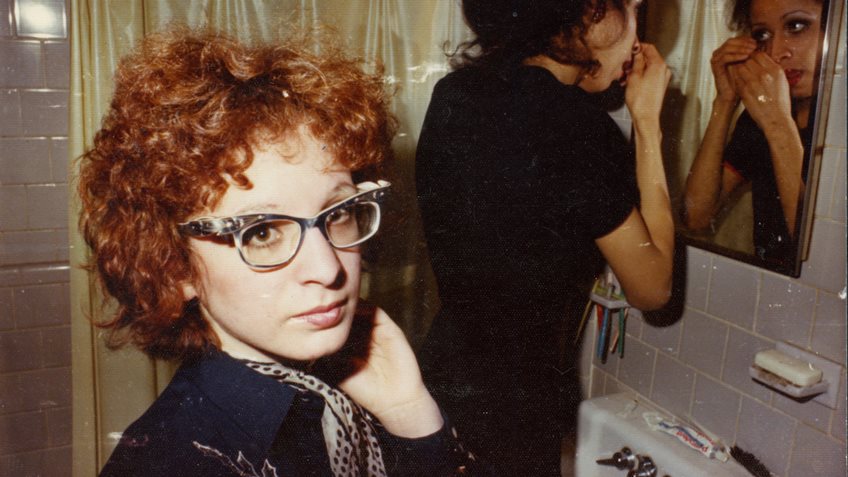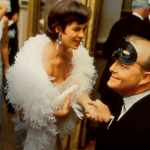Joyce Glasser reviews All the Beauty and the Bloodshed (January 27, 2023) Cert 18, 117 mins.
The “Just Stop Oil” protesters should unglue themselves from masterpieces in western art galleries, leave the tomato sauce at home and learn about how to run a successful campaign to separate art from unworthy sponsors. The prescription? A couple of hours with a former enfant terrible of the art world, 68-year-old photographer Nan Goldin, courtesy of director Laura Poitras.
Her campaign was targeted not at oil companies, but at Purdue Pharma, the pharmaceutical giant owned by the Sackler family that, until it declared bankruptcy to avoid a barrage of lawsuits, manufactured the opioid “painkiller” OxyContin. Goldin’s credentials for spearheading a national campaign to divest museums of the Sackler blood money and family name are not immediately obvious. And that is why Laura Poitras’s unusual documentary is as much a biopic of Nan Goldin as it is a portrait of the organisation she founded in 2018: P.A.I.N (Prescription Addiction Intervention Now).
P.A.I.N is an advocacy group dedicated to ousting the instantly addictive painkilling drug OxyContin and the Sackler family who manufactured and ruthlessly marketed it. To legitimise their drug empire and for tax write-offs they gifted millions of dollars of profits to art institutions, to complete an entire building, or a wing or a gallery, all of which memorialised the Sackler name.
The three Sackler brothers who founded Purdue Pharma grew up in Brooklyn in the 1930s. Little did they know that from the company’s founding in 1952 they were on a collision course with Nan Goldin, born nearby in 1953. The clincher was in 2017, when, after a minor injury, Goldin’s doctor prescribed OxyContin: 3 pills of 40 mg each were, at first, too strong and too many. In a short time 18 pills a day were not enough. Her addiction was short lived but half a million others were not so fortunate.
When the spectacular new Harvard University Art Museum was dedicated in 1985, Dr. Arthur M. Sackler” wrote: “Art is a passion pursued with discipline; Science is a discipline pursued with passion.” The marketing of OxyContin was pursued with the same passion that fuelled Goldin’s art, and her revolt.

The investigative journalist Patrick Radden Keefe, one of the few talking heads in the film, wrote the New Yorker article that blew open the scandal. He explains that Purdue Pharma had a “special role” in the opioid crisis. From the 1990s its marketing policy was to persuade the American medical establishment that strong opioids should be widely prescribed, deriding doctors’ fears about addiction. This documentary does not purport to be an account of the rise and fall of the Sackler dynasty, or about the scope of opioid addiction in the USA. For that Keefe’s book Empire of Pain is highly recommended.
Instead, Poitras, in seven chapters that switch between campaigning scenes and a biopic of Goldin’s life, traces the Sackler/Goldin collision course. Poitras makes the case that Goldin’s life was a long, often painful, preparation for her crowning achievement: stemming the death toll by ridding the art world of the Sacklers.
Goldin was born vulnerable, and her early life was marked by tragedy. Goldin and her older sister Barbara grew up in wealthy Boston suburbs with their dysfunctional parents. At 18, Barbara, who was in an out of institutions in her early teens, lay down on a railway track, a suicide which Goldin’s parents referred to as “an accident”.
The violence of Barbara’s death was a message to judgmental, cold, rigid parents who, Goldin believes, forced Barbara to repress her sexuality and creativity. Goldin herself left home at 14, already smoking marijuana and dating an older man. She enrolled in a Community College, where she was introduced to photography.
Goldin hung out with drag queens and LGBT groups in Boston frequenting a club called The Other Side. She seemed to be transferring her affection for her sister to society’s outsiders in Boston and later, New York, in brightly coloured, dramatic photographs with strong narratives, going against the prevailing taste of the time for minimalist and more abstract black and white fare.
Goldin began capturing in suitably garish colour stock, “slideshows” of people she met in gay clubs, in NYC’s grungy Bowery, in the LGBT subcultures and in NYC’s underground film crowd where she befriended John Waters and his muse Cookie Mueller. Her most famous slideshow being “The Ballad of Sexual Dependency.” In the late 1980s and 1990s she turned to the AIDS scene which was to take the lives of Cookie and her new husband. Goldin stares at us with two black eyes, the result of an abusive relationship and reveals here that she worked in a brothel to buy film, a fact that caught the attention of Irish “No Wave” filmmaker Vivienne Dick with her Super 8 films like Beauty Becomes the Beast.
If there is a hint of sadomasochism in Goldin’s life there is only discipline, determination and artistry in Goldin’s campaigns. Not only is the art never in jeopardy, but she gets the punters participating. The Metropolitan Museum’s largest gallery was named after the Sacklers, making it the target for P.A.I.N’s earliest demonstration. We see members of P.A.I.N. scattering empty prescription bottles around the museum’s Temple of Dendur and then staging a die-in. Demonstrators fall to the ground while bottles float in a tranquil pool.
The Sacklers’ funded an educational centre at the Guggenheim. Goldin responded to Richard Sackler’s comment that “The prescription blizzard will be so deep, dense, and white,” by asking fellow demonstrators to, at a signal, start dropping fake Oxycontin prescriptions into the museum rotunda like falling snowflakes. They then unfurl banners with slogans like “400,000 dead” and “Take down their name”.
Closer to home, we learn that London’s National Portrait Gallery declined a $1.8 million donation from the Sackler Trust towards its $65 million renovations (due to be completed this summer). This was, in part, due to pressure from P.A.I.N and Goldin’s refusal to show her work there if they accepted the money.
Poitras shows that these demonstrations were conceptual art works in themselves and gained public sympathy as well as participation. One by one a jubilant Goldin announces the names of institutions removing the name Sackler from their halls. The film’s title is a quote from Barbara and you can’t help but think that each victorious punch in the air is for Barbara.




